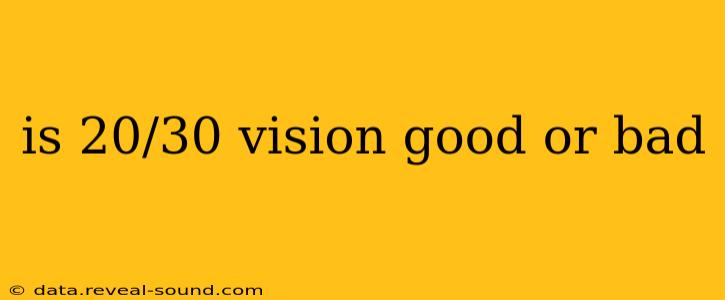Visual acuity, often expressed as a fraction like 20/30, is a crucial measure of how clearly you see. But what does 20/30 actually mean, and is it considered good or bad? Let's delve into the details and address some common questions.
What Does 20/30 Vision Mean?
The notation 20/30 means that at 20 feet, you can see what a person with perfect vision (20/20) can see at 30 feet. In simpler terms, you need to be closer to an object to see it as clearly as someone with perfect vision. While not considered legally blind, it's not considered perfect vision either.
Is 20/30 Vision Good or Bad?
20/30 vision is generally considered within the normal range, although it's slightly below what's considered perfect vision (20/20). Many people with 20/30 vision live full and productive lives without significant visual impairment. However, it's important to understand that it's not the only factor determining your overall visual health. Other factors, like peripheral vision and depth perception, also play significant roles.
What Causes 20/30 Vision?
There are several potential causes for 20/30 vision, including:
- Refractive errors: These are the most common cause, including myopia (nearsightedness), hyperopia (farsightedness), and astigmatism (blurred vision at all distances). These conditions can often be corrected with eyeglasses, contact lenses, or refractive surgery.
- Age-related changes: As we age, our eyes naturally change, potentially leading to a decline in visual acuity. Conditions like presbyopia (difficulty focusing on nearby objects) become more common with age.
- Eye diseases: Some eye diseases, such as cataracts, macular degeneration, and glaucoma, can affect visual acuity. Early detection and treatment are crucial for managing these conditions.
Can 20/30 Vision Get Worse?
Yes, in some cases, 20/30 vision can worsen. This is particularly true for refractive errors in younger individuals. Regular eye exams are essential to monitor changes in visual acuity and address any potential problems early on.
Does 20/30 Vision Require Correction?
Whether or not you need correction for 20/30 vision depends on various factors, including your lifestyle, age, and personal preferences. While you may not require correction for everyday tasks, you might find it beneficial for driving, reading, or engaging in activities requiring sharp vision at a distance. An eye care professional can assess your individual needs and determine if correction is necessary or recommended.
How is 20/30 Vision Diagnosed?
Your eye doctor will perform a comprehensive eye exam, including a visual acuity test using an eye chart (like the Snellen chart) to determine your vision. They'll also assess other aspects of your eye health to identify any underlying causes for the vision impairment.
What are the Treatment Options for 20/30 Vision?
Treatment options for 20/30 vision depend on the underlying cause. If refractive errors are responsible, eyeglasses, contact lenses, or refractive surgery (LASIK, PRK, etc.) may improve your vision. If an underlying eye disease is the cause, specific treatment will be necessary to address the disease itself.
In conclusion, while 20/30 vision isn't perfect, it's generally considered within the normal range and doesn't necessarily indicate a serious problem. Regular eye exams are crucial for monitoring your vision and addressing any issues that may arise. Consult an ophthalmologist or optometrist to determine the best course of action for your specific situation.
